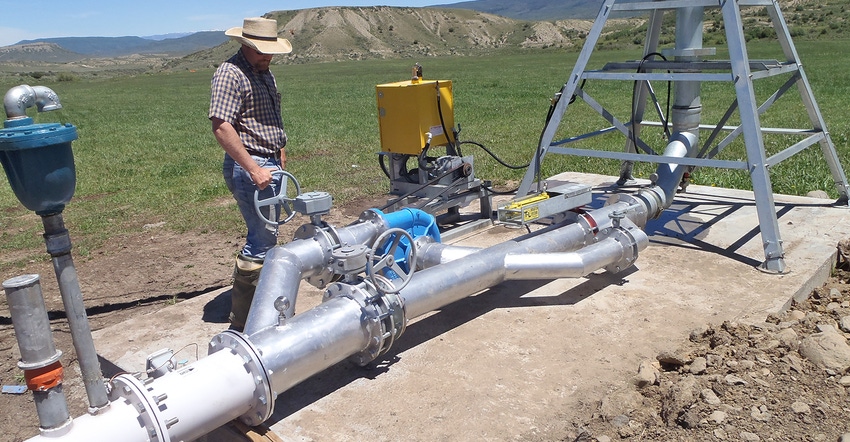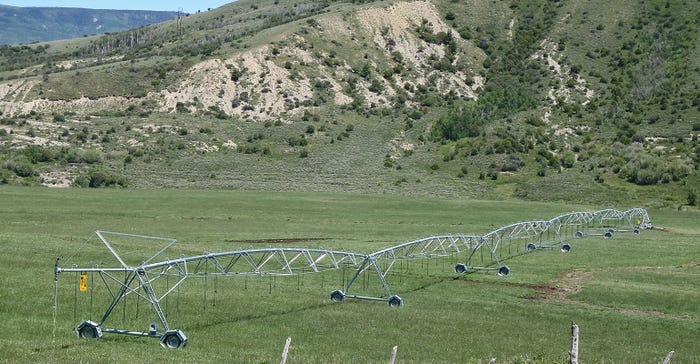December 26, 2017

Editor’s note: This is the second story in a series exploring how ranchers and farmers are benefiting from renewable energy.
Hydropower is taking off in Colorado, Utah, Idaho and other mountainous states thanks in part to modern-day ranchers and farmers wanting to get more green.
Yes, environmentally green, but also green in other ways, like growing more crops with less water and, hopefully, growing more money.
The Fish and Cross Ranch in northwest Colorado near Yampa has converted from flood irrigation to center-pivots and big guns, and the results have been “phenomenal,” says Tyler Snyder, a 2010 University of Wyoming agribusiness major who manages the family ranch. “We can irrigate more ground with a lot less water, and our grass hay crops have nearly doubled," he says. "we still buy the same amount of water, but we're using the water much more efficiently and are irrigating a lot more acres. Plus, the quality of the grass is so much better."
Those comments wouldn’t surprise agricultural producers in the West who have successfully converted to more efficient irrigation systems. But their interest might be sparked if they learned that Mother Nature is powering the pivots and pressurizing the big guns instead of expensive diesel or electricity.
Snyder, with the help of family, friends, private contractors and the USDA’s Natural Resources Conservation Service, installed six center pivots that are powered by a relatively simple system called “hydro-mechanical.”
Water gushes down a pipeline buried on a mountain slope and gains enough pressure to power a turbine. But instead of producing electricity, turbines in a hydro-mechanical system drive and pressurize the center pivots.
Because Snyder received financial assistance from NRCS to install the system, the payback time will be less than five years.
“When my parents bought this ranch in 2006, one of their primary goals was to create a ‘legacy ranch’ that could sustain our family for generations. That means creating multiple business entities within the ranch, and also making the ranch as efficient as we can," says Snyder, who notes that the family runs a cow-calf and stocker operation in addition to offering hunting and fishing trips.

HYDRO TURF: Ranchers having water resources and elevation gain can convert inefficient flood irrigation to highly efficient hydropowered center-pivot systems, like this one on the Snyder family ranch in Colorado.

Looking ahead
The Snyders look at hydropower as part of that legacy.
“Once we get the system paid off, there will be virtually no operating costs—unlike diesel and electric systems. Plus, it’s pretty much a zero-carbon system,” Snyder notes. “I’m hoping that our son, Tilman, can put in another hydro project in 18 or 20 years. This is all about sustainability.”
And it’s also about stewardship of land, water and energy resources, and that’s why NRCS and the Colorado Department of Agriculture are collaborating to promote the conversion of flood irrigation to center pivots powered by hydro in the state.
Flood irrigation, especially in mountainous areas, is notorious for causing erosion, wasting water and potentially polluting streams as water runs down deep irrigation ditches and then off of agricultural fields, carrying with it sediment and, in some cases, fertilizer, pesticides and herbicides.
Vance Fulton, an NRCS engineering technician in Steamboat Springs, Colo., who assisted the Snyders and another area ranch to develop hydro-powered irrigation projects, says that some ag producers in northwest Colorado are facing substantial rate hikes in their purchased irrigation water, which is another driving force behind more efficient irrigation systems.
And, Fulton emphasizes, the green benefits of hydro power are a huge plus.
“A number of ranchers in our area are expressing an interest in installing hydro-powered irrigation systems,” he says.
Adds Snyder: “I think it’s definitely worth it if you have adequate water resources and elevation gain. Yes, I definitely recommend this to other agricultural producers.”
Waggener writes from Laramie, Wyo.
About the Author(s)
You May Also Like




